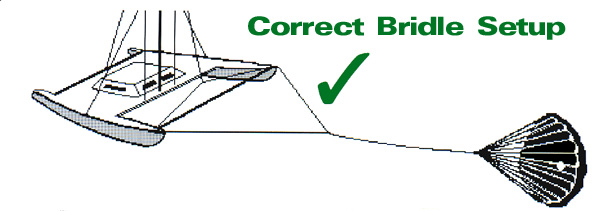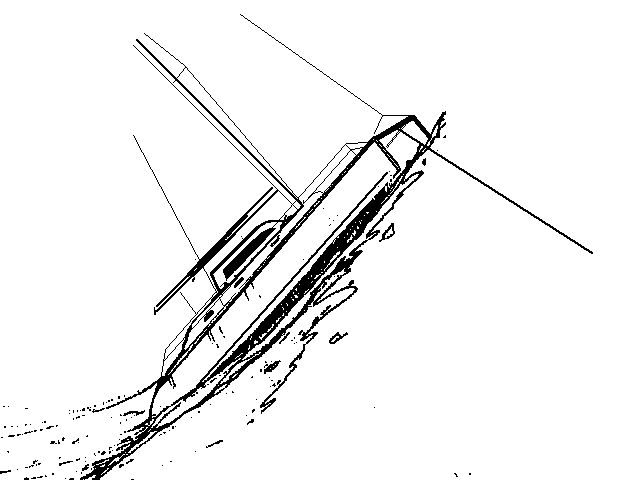CORRECT BRIDLE SETUP
 Multihull designers and safety experts around the world agree that FULL WIDTH bridles (shown above) should be used by multihulls for anchoring inshore and offshore in severe conditions. Because this bridle is secured to the extreme outboard tips of the strong hulls themselves it affords maximum leverage and security when it comes to keeping the yacht facing squarely into the seas. Ideally, catamarans should be set up at the factory with heavy duty, well backed up pad-eyes or rollers to accommodate a FULL WIDTH - ordinarily SYMMETRICAL - bridle.
Multihull designers and safety experts around the world agree that FULL WIDTH bridles (shown above) should be used by multihulls for anchoring inshore and offshore in severe conditions. Because this bridle is secured to the extreme outboard tips of the strong hulls themselves it affords maximum leverage and security when it comes to keeping the yacht facing squarely into the seas. Ideally, catamarans should be set up at the factory with heavy duty, well backed up pad-eyes or rollers to accommodate a FULL WIDTH - ordinarily SYMMETRICAL - bridle.
WRONG BRIDLE SETUP
Many modern catamarans have a centrally located anchor roller situated amidships on the weakest part of the boat, i.e., the forward aluminum crossbar that holds the trampoline up. This arrangement may be convenient for casual anchoring in relatively stable conditions, but it is not advisable for storm anchoring. On some catamarans where there is a solid foredeck (notably Privilege and Prout) the problem is less critical. On other catamarans, however, leading a single line, or even the "half bridle" (shown above) through the center bow roller is not advisable.
The aluminum crossbar that holds up the trampoline is usually far weaker than the mast. It is not uniformly braced like a mast, and many large holes have to be drilled into the middle of it to accommodate the anchor roller, and/or seagull striker. The severe up, down, outward and diagonal forces exerted by the anchor rode onto the middle of this relatively weak aluminum cross member (as the bows pitch acutely up and down in a storm) can cause it to fail, with serious consequences. At the very least the yacht will no longer face into the seas. In a worst case scenario, failure of the crossbar may lead to the loss of the entire mast and rig and/or capsize. It seems very likely that this was the cause of the capsize and ultimate loss of four lives from Bayette (S/C-19).

In setting up your boat, make sure that the attachment points for the bridle as sufficiently strong. Some boats, such as the Robertson &Caine Leopards come with a very strong bracket on the inside aspect of each bow.
Others may need some beefing up. See, for example, the custom built attachment points that Dave Abbott added to his Privilege catamaran Exit Only (scroll down to find the section on Sea Anchor Chainplates). And note, too, his comment that "Parachutes work extremely well on our catamaran".
Love the Drag Device Database? Help us to keep it free for all mariners by making a tiny donation to cover our server and maintenance costs. Thank You!

Hi. I own a 30 ton high windage fly bridge version and 2 roller furlers up front, of a Lagoon 52 sailing catamaran. With strong winds at anchor using the conventional cat bridle the cat yaws considerably like many monohulls. I would like to know if and how the Pardey bridle for a sea anchor can be used to keep it in a hov to position, considering the 2 bow points of a catamaran?
Cheers from Australia
Michael
Hi Michael
That is a very interesting question to which I don’t know the answer! Perhaps the way to experiment on this would be to try out the Pardey bridle on a regular anchor some time? You might try putting the bridle to one bow, and then to the opposite stern, eg. port quarter plus starboard bow. That should give you some idea of how it might behave on a sea anchor. Please do report back with your experiences if you try this, as I have not heard of anyone else doing it – yet!
Thanks
Noel
I was thinking that exact same question and wondering whether you’d secure to bow and same hull stern, bow & opposite bow or bow and opposite stern. You’d at least want to lead the bridle with the pulley on it back to the aft bollards and then onto the genoa winch.
With its higher windage and less in the water, a cat may be more affected by the wind than that waves, but the high topsides and the lack of keel makes me think you would be better to lie square to the waves than the wind if they were not aligned (in which case bow/bow would be fine).
I’d love to hear what others think.
We’re about to go trans-Tasman (mid-late October) in a Lagoon 440 so might try it out before we go. If so, I’ll report back.
Did you try it?
I would worry that staying Square to the waves does not allow the boat to create a slick there by reducing or knocking down breaking waves as they approach the vessel as described here:
https://youtu.be/4SAXRH42Df0
I am late to this discussion, but nothing is said about the length of the bridle arms. LeSueur suggests that each leg of the bridle equal the beam, ergo the entire bridle = 2x beam. I have found that to be optimal. In my observations, when a multihull yaws to a bridle, the legs are usually too short, although the same effect can also occur if the legs are too long.